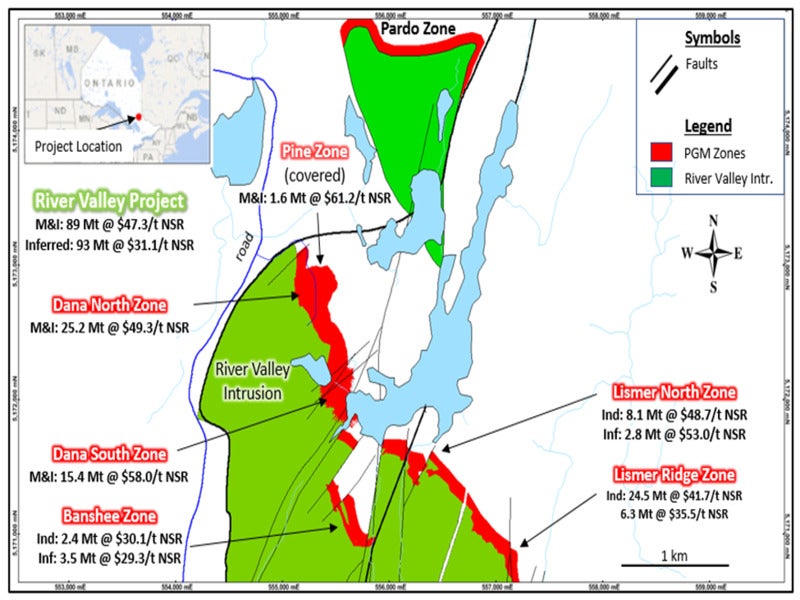The River Valley Project is an undeveloped platinum group metals project located in Ontario, Canada. Palladium is the dominant metal in the property, while smaller amounts of platinum, gold, rhodium, silver, copper, nickel and cobalt are also found.
The project is fully owned by Canada-based mineral exploration and development company New Age Metals (NAM).
A preliminary economic assessment (PEA) for the project was completed in June 2019. The report estimated a pre-production capital requirement of $495m for the project.
In June 2023, NAM announced positive results of a new independent PEA prepared in accordance with NI 43-101 for the palladium project. River Valley is expected to process 38.6 million tonnes (Mt) over 16 years.
Average annual palladium production is expected to be 47,400 ounces.
The next steps at the property will include identifying areas for drilling to expand mineral resources and discover new mineralised zones. The company also plans to test new technologies to improve metal recoveries.
River Valley Location Details
The River Valley Palladium Project is located approximately 100km east of the City of Sudbury, Northern Ontario.
According to a technical report published in 2021, the property comprises two mining leases, 310 single cell mining claims and 18 boundary cell mining claims within Dana, Janes, McWilliams, and Pardo Townships.
The mining leases and claims encompass a total area of 10,700ha.
Ownership History
Exploration history in the region can be dated back to 1960s.
The River Valley Palladium project was acquired by New Age Metals (formally known as Pacific North West Capital) in 1998.
The company identified significant PGM occurrences on the property and signed a joint venture agreement with Anglo Platinum in 1999.
NAM continued to operate the project and acquired Anglo Platinum’s 50% stake in River Valley in January 2011 to become 100% owner.
In 2016, NAM made another acquisition that increased the size of its land position to 15,800acres and increase the portion of the River Valley Deposit from 12km to 16km in strike length.
Geology and Mineralisation
The River Valley Palladium Deposit is a part of the Paleoproterozoic East Bull Lake Intrusive Suite. The intrusions feature geochemical characteristics consistent with being derived from fractionated tholeiitic or high-alumina tholeiitic parental magmas.
The 200km2 River Valley Intrusion is the largest and easternmost of the East Bull Lake Intrusive Suite occurring within the Grenville Front Tectonic Zone.
The River Valley Intrusion is an around 900m shallow-dipping and layered body. The dominant rock types found at the deposit include brecciated and massive leuco-gabbronorite and leucogabbro with gabbro and anorthosite.
There are two types of mineralisation- contact type PGE mineralisation hosted mainly in the Breccia Unit, and reef type PGE mineralisation found internally within the River Valley Intrusion.
The copper-nickel-PGE mineralised host rocks are primarily located in the Breccia Unit, situated at the base of the intrusion above the basal contact with the Archean footwall rocks.
River Valley Mineral Resource Estimate
According to the updated 2021 mineral resource estimate, the River Valley project is estimated to contain 89.9Mt grading 0.54g/t palladium (Pd), 0.21g/t platinum (Pt), 0.04g/t gold (Au) and 0.06% copper (Cu), or CDN$47.58/t NSR in the Measured and Indicated categories.
Inferred resource estimate stands at 94Mt grading 0.35g/t Pd, 0.16g/t Pt, 0.04g/t Au and 0.06% Cu.
Contained metal contents at the River Valley project include 2.3Moz Pd+Pt+Au in the Measured and Indicated classifications and 1.6Moz Pd+Pt+Au in the Inferred classification.
Mining and Processing
The River Valley Project is expected to be mined by open pit and underground methods.
Initially, open pit mining would be carried out at the northwest end of the deposit, near the proposed process plant site.
The plan involves a series of five open pits, starting at Dana North Zone and advancing south-easterly to the Varley Zone.
A fleet of 90tonne haul trucks, 10m3 excavators, and 254mm diameter hole rotary drills will be utilised.
Higher grade underground mineralisation will be mined during production years two to seven totalling around 3Mt of process plant feed.
The mine will employ sublevel longhole stoping with cemented rock backfill as the underground mining method.
According to the updated PEA, the process plant will have a feed rate of 2.5Mt per year of mineralised material. It is expected to result in an average annual payable Pd production of 47,400oz.
The process plant will be designed to produce a single copper sulphide and PGM concentrate.
The Run-of-Mine (ROM) material will be crushed in a single primary jaw crusher to 150mm sizing. The SAG mill in closed circuit with a recycle pebble crusher and ball mill will produce flotation feed.
The final concentrate will be produced following rougher flotation, regrinding of the associated concentrate, and three-stage cleaning.
The concentrate will undergo dewatering, filtering, drying before it is shipped to the smelter.
Infrastructure
The project will include a Tailings Management Facility (TMF) of a two-cell valley impoundment to enable safe and permanent storage for tailings for the first seven years of the mining.
The remaining tailings would be stored in the Dana open pit.
A dedicated 44kV feeder line from Crystal Falls will supply power for the facility.
The project area is linked to Sudbury by a network of all-weather highways, roads, and rail beds.
Contractors Involved
The new Preliminary Economic Assessment PEA, the results of which were announced in June 2023, was developed by a group of independent consultants including P&E Mining Consultants; D.E.N.M. Engineering; Knight Piésold; and Story Environmental.
P&E Mining Consultants also completed the Updated Mineral Resource Estimate for the River Valley Deposit, effective September 2021.
In 2017 and 2018, Abitibi Geophysics carried out Induced polarization (IP) geophysical surveys.
The first PEA for the palladium project was done by P&E Mining Consultants, DRA Americas and WSP Canada.
In March 2022, Knight-Piésold completed the site geotechnical investigation work which included bedrock and surficial drilling and pit excavations.





